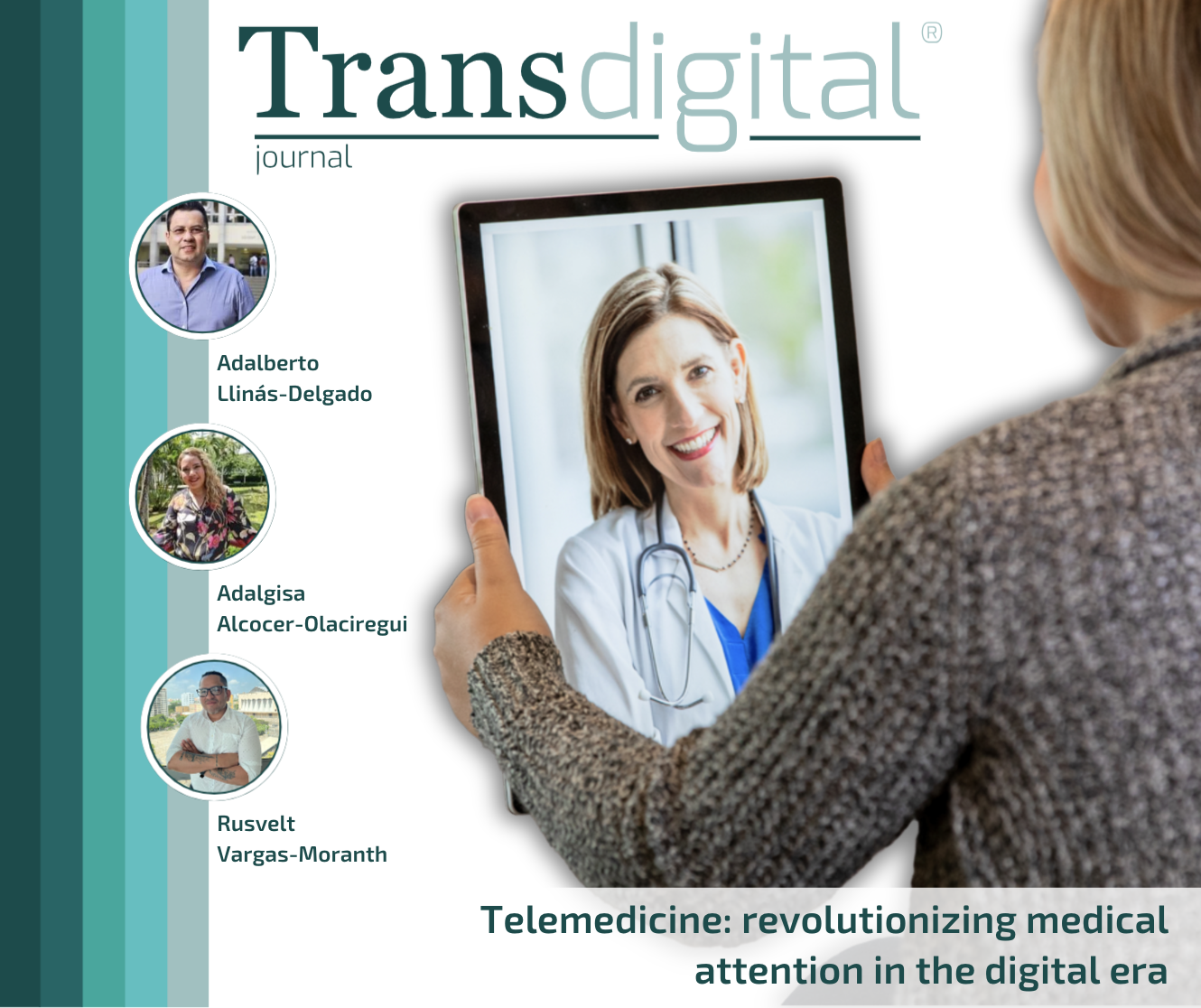Telemedicine: revolutionizing medical attention in the digital era
DOI:
https://doi.org/10.56162/transdigital259Keywords:
telemedicine, medical attention, digitalAbstract
Telemedicine has emerged as a transformative approach to healthcare delivery, taking advantage of advances in communication technology to bridge the gap between patients and healthcare professionals. The aim of this study was to explore the evolution, benefits, challenges, and prospects of telemedicine, based on the literature of the last ten years. A documentary review of scientific publications obtained from bibliographic databases was made. As main results, the article emphasizes the potential of telemedicine to improve access to healthcare, as well as improve patient outcomes and mitigate the burden on traditional healthcare systems. In addition, it addresses concerns about data security, regulatory frameworks, and ethical considerations associated with the implementation of telemedicine. The findings of this review underscore the need for continued further research, innovation, and policy development to maximize the potential of telemedicine and shape the future of healthcare. As a conclusion, it is obtained that telemedicine is present and future for the development and innovation in health sciences.
References
Ahmad, R., Salah, K., Jayaraman, R., Yaqoob, I., Ellahham, S., & Omar, M. (2021). The role of blockchain technology in telehealth and telemedicine. International Journal of Medical Informatics, 148, 104399.
Asociación Americana de Telemedicina (2020). ¿Qué es la telemedicina? www.americantelemed.org/learn/what-is-telemedicine.
Bashshur R. (2022). On the definition and evaluation of telemedicine. Telemed J. Spring, 1(1), 19-30.
Bashshur, R., Bashshur, M., & Krupinski, E. (2022). Telemedicine, precision medicine, and regionalization. Telemedicine and e-Health, 28(5), 599-601.
Bucci, S., Schwannauer, M., & Berry, N. (2019). The digital revolution and its impact on mental health care. Psychology and Psychotherapy: Theory, Research and Practice, 92(2), 277-297.
Cáceres-Méndez, E., Castro-Díaz, S., Gómez-Restrepo, C., & Puyana, J. (2011). Telemedicina: historia, aplicaciones y nuevas herramientas en el aprendizaje. Universitas Médica, 52(1), 11-35.
Casado García, M., & Santervás Sanz, A. (2012). Estado del arte de la Telemedicina en España y Europa. DSSI-1.3 ITT Sistemas de Telecomunicación.
Chau, P., & Jen-Jwa, P. (2002). Investigating healthcare professionals’ decisions to accept telemedicine technology: an empirical test of competing theories. Information & management, 39(4), 297-311.
Currell, R., Urquhart, C., Wainwright, P., y Lewis, R. (2000). Telemedicine versus face to face patient care: effects on professional practice and health care outcomes. Cochrane Database Syst Rev, 2(2).
Fernández, A., & Oviedo, E. (Eds.) (2010). Salud electrónica en América Latina y el Caribe: avances y desafíos. CEPAL. https://hdl.handle.net/11362/32848
Fields, B. (2020). Regulatory, legal, and ethical considerations of telemedicine. Sleep medicine clinics, 15(3), 409-416.
Groom, L., McCarthy, M., Stimpfel, A., & Brody, A. (2021). Telemedicine and telehealth in nursing homes: an integrative review. Journal of the American Medical Directors Association, 22(9), 1784-1801.
Hasannejadasl, H., Roumen, C., Smit, Y., Dekker, A., & Fijten, R. (2022). Health Literacy and eHealth: Challenges and Strategies. JCO Clinical Cancer Informatics, 6, e2200005.
Hazenberg, C., Aan de Stegge., Van Baal, S., Moll, F., & Bus, S. (2020). Telehealth and telemedicine applications for the diabetic foot: A systematic review. Diabetes/metabolism research and reviews, 36(3), e3247.
Jha, A., Sawka, E., Tiwari, B., Dong, H., Oh, C., Ghaemi, S., & Jha, A. (2021). Telemedicine and community health projects in Asia. Dermatologic Clinics, 39(1), 23-32.
Kaplan, B. (2020). Revisiting health information technology ethical, legal, and social issues and evaluation: telehealth/telemedicine and COVID-19. International Journal of Medical Informatics, 143, 104239.
Klaassen, B., Van Beijnum, B., & Hermens, H. (2016). Usability in telemedicine systems—A literature survey. International journal of medical informatics, 93, 57-69.
Maldonado J., Marques A., & Cruz A. (2016). Telemedicina: desafios à sua difusão no Brasil. Cadernos de Saúde Pública, 32 (S2): e00155615. https://doi.org/10.1590/0102-311X00155615.
Manocchia, A. (2020). Telehealth: Enhancing care through technology. Rhode Island Medical Journal, 103(1), 18-20.
Ministerio de Salud y Protección Social (2006, 8 de mayo). Resolución 1448. Condiciones de Habilitación para las instituciones que prestan servicios de salud bajo la modalidad de Telemedicina. https://repositorio.saludcapital.gov.co/handle/20.500.14206/13611.
Ministerio de Salud y Protección Social (2013, 27 de diciembre). Resolución 5521. Por la cual se define, aclara y actualiza integralmente el Plan Obligatorio de Salud (POS). Diario Oficial No. 49019. https://www.minsalud.gov.co/Normatividad_Nuevo/Resoluci%C3%B3n%205521%20de%202013.PDF
Miotto, R., Wang, F., Wang, S., Jiang, X., & Dudley, J. (2018). Deep learning for healthcare: review, opportunities and challenges. Briefings in bioinformatics, 19(6), 1236-1246.
Nomura, A., Tanigawa, T., Muto, T., Oga, T., Fukushima, Y., Kiyosue, A., & Satake, K. (2019). Clinical efficacy of telemedicine compared to face-to-face clinic visits for smoking cessation: multicenter open-label randomized controlled noninferiority trial. Journal of medical Internet research, 21(4), e13520.
Pagliari, C., Sloan, D., Gregor, P., Sullivan, F., Detmer, D., Kahan, J., & MacGillivray, S. (2005). What is eHealth (4): a scoping exercise to map the field. Journal of medical Internet research, 7(1), e391.
Patil, S., & Cross, R. (2018). Current landscape of telemedicine practice in inflammatory bowel disease. Inflammatory Bowel Diseases, 24(9), 1910-1917.
Roth, C., Papassotiropoulos, A., Brühl, A., Lang, U., & Huber, C. (2021). Psychiatry in the digital age: A blessing or a curse? International journal of environmental research and public health, 18(16), 8302.
Speyer, R., Denman, D., Wilkes-Gillan, S., Chen, Y., Bogaardt, H., Kim, J. y Cordier, R. (2018). Effects of telehealth by allied health professionals and nurses in rural and remote areas: a systematic review and meta-analysis. Journal of rehabilitation medicine, 50(3), 225-235.
Verma, N., Buch, B., Taralekar, R., y Acharya, S. (2023). Diagnostic Concordance of Telemedicine as Compared with Face-to-Face Care in Primary Health Care Clinics in Rural India: Randomized Crossover Trial. JMIR Formative Research, 7(1), e42775.
World Health Organization-WHO (OMS). (2010). Telemedicine. Opportunities and developments in member states. Report on the second global survey on eHealth. Global Observatory for eHealth series. Volume 2. http://www.who.int/goe/publications/goe_telemedicine_2010.pdf

Downloads
Autor de correspondencia
El autor de correspodencia se identifica con el siguiente símbolo: *Published
How to Cite
License
Copyright (c) 2023 Adalberto Llinás-Delgado, Adalgisa Alcocer-Olaciregui, Rusvelt Vargas-Moranth

This work is licensed under a Creative Commons Attribution 4.0 International License.
All articles in Transdigital are licensed under a Creative Commons Attribution 4.0 International License. Authors hold the copyright and retain publishing rights without restrictions.









